|
FAQs on Anemone Health
10
FAQs on Anemone Disease: Anemone
Disease 1, Anemone
Disease 2, Anemone Disease 3,
Anemone Disease 4, Anemone Disease 5, Anemone Disease 6, Anemone Disease 7, Anemone Health 8, Anemone Health 9, Anemone Disease 10, Anemone Disease 11, Anemone Disease 12, Anemone Disease , &
FAQs on Anemone Disease by Category:
Diagnosing,
Environmental (Pollution/Poisoning,
Lighting...), Nutritional,
Social (Allelopathy),
Trauma,
Pathogenic (Infectious, Parasitic, Viral)
Predatory/Pest,
Treatments
FAQs on Anemone Disease by Genus, Species: Condylactis
Disease, Sebae Disease,
LTA Disease, Magnificent Anemone Disease, BTA Disease, Carpet Anemone Disease, TWA Anemone Disease, Sebae Disease,
Related Articles: Anemones,
Bubble Tip Anemones, LTAs, Cnidarians, Dyed
Anemones,
Related FAQs: Cnidarian Disease, Anemones,
Anemones 2, LTAs, Caribbean
Anemones, Condylactis, Aiptasia
Anemones, Anemones and
Clownfishes, Anemone
Reproduction, Anemone
Identification, Anemone
Compatibility, Anemone
Behavior, Anemone
Selection, Anemone
Placement, Anemone
Feeding, Anemone
Systems, Anemone
Lighting,
|
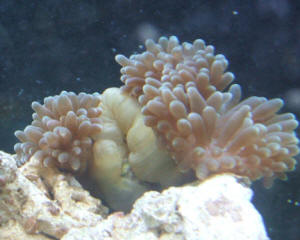 |
 |
New Print and
eBook on Amazon:
Anemone Success
Doing what it takes to keep Anemones healthy long-term
by Robert (Bob) Fenner
|
|
Sick Anemone - Nitrate Issues? 1/8/10
Hi There,
<Hello Sheridan>
My name is Sheridan, and I have recently inherited a 164gal reef
tank. I have kept fresh water aquariums but this is my first
salt. They neglected it for over twelve months and all corals
have unfortunately died. I received the tank covered in red slime
but the surviving inhabitants seem ok (2 Cinnamon Clownfish, 2
Chromis, 2 Branded Coral Shrimp, 1 Talbot Damsil <Damsel>
(I don't think that is spelt <spelled> right!), 1
Foxface and 1 black long spiked urchin)
The nitrates were originally off the chart, guessing around
150ppm or so,
<Yowsa.>
with 6 weeks of water changes and removal of all dead skeletons,
etc, the nitrates are down to 70-80ppm and falling.
<An improvement.>
My mother, bless her, purchased a Bubble Tipped Anemone for the
tank without my prior knowledge. The plan was to be stabilise the
tank and then start with the new inhabitants....but alas I
don't know what to do. I have placed it high in the tank and
have not removed it from the rock it was purchased on.
I have set up a 30gal quarantine tank (it is only 24hrs old,
seeded with substrate and a very small amount of water from the
large tank) and would like to know if you recommend leaving the
anemone where it is, move it to an un-cycled QT or return it to
LFS?
<Return it to the LFS.>
I am turkey-baster-feeding it brine shrimp and It is reacting ok,
but during feeding and at night its mouth appears quite slack and
I am worried about the colour - could you please comment?
<Yes, do read here and related articles/FAQ's.
http://www.wetwebmedia.com/marine/inverts/cnidaria/anthozoa/bubbletipanemones.htm>
Attached is a photo of the anemone and the tank for size
reference, although the anemone was not in it at the time of
photo.
Thank you, and sorry for the short story!
<You're welcome, and in future queries, please provide
more information as to equipment used, lighting, filtering
methods, etc. James (Salty Dog)>
Sheridan
|
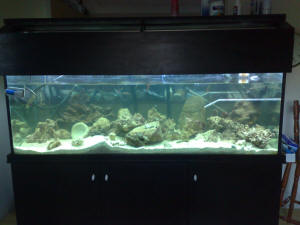 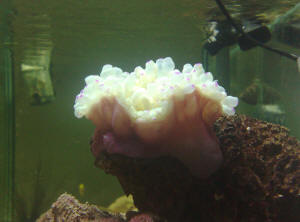 |
Anemone quarantine -- 10/31/09
Dr. Fenner,
<Heeeee! Maybe for Halloween!? Just Bob, please Terry. I have no
doctorate>
I have a question about quarantining an anemone. My quarantine tank is
not setup (lighting wise) for an anemone, because I have a FOWLR setup.
I've never needed strong lighting. I only wish to keep
anemone's in the system long term, therefore the display tank has
been setup for anemones. I have a 150 gallon high tank with 0 nitrite
and ammonia, and .05 nitrate. I have 500 watts of MH (14K), 1 96 watt
t5
(20K), and 1 96 watt (10K). The sand bed is 6-7 inches, the system has
been established for one year. I have a 50 gallon refugium with
Chaetomorpha, and live rock in it. There is approximately 130 lbs.
Of
live rock in the system. All the inhabitants are reef safe with the
possible exception of a 5 in. Blue angel which hasn't been tested
yet.
<Sometimes these will go after/eat anemones>
I also have 2 other tanks if something goes after the anemone, I can
the fish. I am mainly concerned about quarantining the water the
anemone is in than the anemone itself due to ich and other possible
bacterium/viruses which may inhabit the water. Any suggestions?
Thanks,
Terry Baldwin
<Yes... to move some of the water back/forth from the QT and
main/display systems on a daily basis... to allow all to "get
used" to each other over time... A week or two should prove the
health of the new animal, and the mixing of waters will ease
transition. Bob Fenner>
Re: Anemone quarantine
Does the anemone not need light on a daily basis while in
quarantine?
<Yes... if the process is going to go on for many days. BobF>
Anemones/Health 7/29/09
Hi guys and gals
I love this site, thank you for what you do.
<You're welcome, and glad you enjoy.>
I have (1) yellow Sebae Anemone (1) purple tip Sebae and (1) Rose
Anemone set up in (2) tanks (1tank) a 90 gal. And (1tank) 30 gal
,plumbed together.
The yellow and purple tip is housed in the (30gal. tank).The yellow
Sebae use to be bright yellow and opened to approximately 8"
around .For the last 2 months it is not opening as large and now its
color is very pale yellow and some of its tentacles are even showing
some light brown to it.
<Sounds like this anemone was dyed, tan to light brown is generally
what is found in the wild.>
The purple tip has no color lost but it is only opening a 1/4 of it
size (normally 10" around).
The Rose Anemone is in the main (90gal.tank) seems to be fine.
<Sounds about right, the Bubble Tip (Rose) Anemone is the easier one
to maintain.>
Lights-14,000k 250watts MH.
back ground info-----
I changed my lighting about 1 1/2 month ago from Coralife (2) actinic
and (2) 10,000 t-5 to Aqua traders, a 10,000k 150 watt fixture with (2)
actinic in hopes that better lighting would help.
no help!!!!
I feed the anemones (2) times a week
<Too much, once weekly is plenty.>
with (1) krill each and alternate with 1/2 of a silver side for each
anemone.
water parameter- phos-20ppm, nitrate-10 to 20 ppm, cal. KH, and pH and
temp. are all within range.
<Your high phosphate level is contributing to your red slime
problem, and I'd try to keep the nitrates under 10ppm.
Are you using a protein skimmer?>
all other tank inhabitants are normal ( Leather Coral, Colt Coral,
Birds Nest, Bubble Coral and fish are all normal.
<Not a good idea mixing corals with anemones, allelopathy problems
can arise.>
I have the (2) tanks on reverse lighting periods.
I am dosing Vodka at 3ml. a day for the whole system as they are
plumbed together.
I have some red slime algae on the back wall of the 30gal tank.
Water movement and flow is good.
please advise if anyone has any suggestions.
<The majority of all anemone specimens sold in the trade don't
even live a few months... Major reasons are poor collection,
processing, shipping/handling, and likely an equal amount due to being
placed in a
poor environment by dealers. Heteractis Crispa (Sebae Anemone) is
difficult to keep for any length of time even under the best conditions
for reasons stated above. Do read/learn more about these Cnidarians
here.
http://www.wetwebmedia.com/marine/inverts/cnidaria/anthozoa/heteraccrispa.htm
http://www.wetwebmedia.com/marine/inverts/cnidaria/anthozoa/bubbletipanemones.htm>
Thanks,
<You're welcome. James (Salty Dog)>
Khoa Adams
Re: BTA shrinking tentacles more info... Allelopathy
4/24/2009
Hi I sent you guys a question earlier this morning about my bubble tip
anemone problems. I sent a picture of him, and listed all water and
lighting other livestock etc. I did not mention the other corals in my
tank. I have been reading on your site all day and I'm wondering if
the brown, gold, and green Zoanthids in my tank could be the
problem.
<Mmm, yes>
I thought it was the new light bulbs. I will continue researching on
your site, but wanted to add to my earlier e mail that there are a lot
of Zoanthids in my tank, also some metallic green star polyps, a toad
stool,
and a mushroom.
<All these can be toxic to other Cnidarians... most so the
Zoanthids>
If the Zoanthids are the problem, should I get rid of them. Our tank
has been set up for a long time and they have multiplied a lot. Will my
BTA survive? What's the easiest way to get rid of them? Thanks.
Dawn D.
<Mmm, best for you to read:
http://wetwebmedia.com/cnidcompppt.htm
and the linked files above... till you understand your situation,
options, consequences. Bob Fenner>
|
bubble anemone shrinking tentacles... Nope... sent
secondarily 4/24/2009
Hi Crew. Thanks in advance for your help. I am needing some help
with my bubble tip anemone.
<Not... see here:
http://wetwebmedia.com/marine/inverts/cnidaria/anthozoa/anemones.htm
Can't be sure from your image, but from the color of the
pedicle, the verrucae... this looks like a Heteractis
magnifica>
I purchased him at my LFS about 2 months ago. I am in the process
of trying to correctly identify him using your web site, but when
I got him he had beautiful frosty bulbs with purple on the
tips.
<Mmmm?>
He was fine, behaving and eating as I would expect based on the
research I've done about them. About a month ago we replaced
the bulbs in our aquarium. Compact fluorescents 2 each of 65w
dual actinics and 2 each of 10,000K dual daylights.
<How far away...?>
Our tank is a 90 gallon with a 15 gallon sump. No mechanical
filtration. 6 inches live sand, 110 lbs live rock, a pro clear
aquatics 150 protein skimmer in the sump, and a pacific coast
imports chiller that keeps the temperature at a constant 78.
specific gravity is always 1.024 with water that has evaporated
replaced each day with RO water from a Kent RO unit. We do weekly
10% water changes. Calcium is about 400, PH is 8.2-8.3. no
ammonia etc. alkalinity is on the high side of normal according
to my test kit. The aquarium has been set up for over 3 years.
This is the first time adding a BTA. Also I change a carbon
pillow monthly in the sump. We have four ocellaris clowns, one
desjardinii tang, one regal tang, one yellow tang, a coral
beauty, and a male and female mandarin dragonet. Also a lot of
snails, some hermit crabs a couple cucumbers a skunk cleaner
shrimp and two red fire cleaner shrimp.
Anyway, since we replaced the light bulbs, our BTA has not been
well. His color on his body is still the same, brown, but his
tentacles have shrunken more and more until they are almost gone.
He still eats and excretes waste. I feed PE mysis shrimp mixed
with Cyclopeeze and formula two flakes daily to all tank
inhabitants, and I feed small chunks of shrimp and scallops from
my local grocery store to the BTA every few days. Usually he
takes it.
Occasionally he lets it go. Are the lights the problem?
<Perhaps a contributing factor... This amount (intensity) of
light is insufficient for either Entacmaea or a
Magnificent...>
Should I move him?
<I would try this>
He is attached to a large rock that can be moved lower in the
tank. I am attaching a photo that I took of him this morning. At
night when the lights are out his disk expands like a big soft
pillow full of water, about 4 or 5 inches across, but the bulbs
still stay shrunken. His mouth is tight and smooth. Can you
guys(and or girls) help? Thank you so much. I love your site!
<Please use it. Bob Fenner>
|
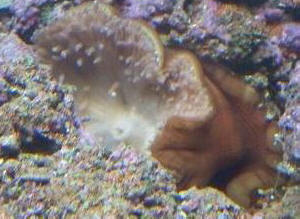 |
|
Anemone issues or normal? Anemone/Health
3/24/09
WWM Crew,
<Mike>
Love the site, certainly one of the best online!!
<We definitely have the traffic.>
Now I recently acquired an Anemone with a setup I bought, has a
Tomato clown currently hosting. I've been keeping them in my
frag tank, since I tried an Anemone before and not much luck.
Needless to say I'm gun shy about putting in my main tank.
The way he looks in this picture only scares me more. First of
all my lights 250 MH new 10k bulb, Tank is 45 Gal corner hex, Amiracle wet dry, live rock instead of bio balls, Berlin 60
protein skimmer.
<What kind of light is the anemone under at present? This
anemone requires intense lighting to survive, more along the
likes
of your main tank lighting.>
In the evening about 5 hours into the light cycle, it shrinks up,
recently started showing his innards, see picture. One pic is
taken today deflated, mouth exposed, other is normal pic taken
about two weeks ago. In the morning, he is back out puffed up
with water as it should be. I've had it about a month,
has eaten krill pieces, plankton, silverside pieces, and anything
I feed the fish and corals. Is this normal?
<Which, you feeding it or the anemone's appearance?
Anemone doesn't look real healthy and likely on it's way
out. Your anemone appears to be a Condylactis and they are not
hosting anemones. If the clownfish is in with him, I'd remove
the clown, is likely causing damage/stress to the anemone. I am
in agreement with you, I would not put this anemone in the
display tank.>
Water Parameters as of yesterday:
Calcium 320
Nitrate 0
pH 8.8
dKH 125.3
<Your reading indicates KH to me, dKH would be 6.9>
Phosphate 0
Ammonia 0
Nitrite .10
By the way, can you identify it as well?
<As above.>
Thanks for the helpful/wealth of information.
<You're welcome. James (Salty Dog)>
Mike
|
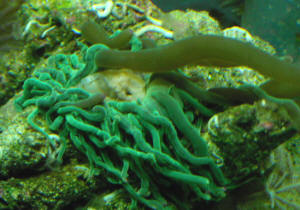 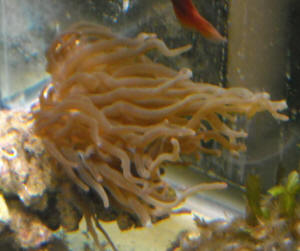 |
|
Re: Anemone issues or normal?
3/24/09
Thanks for the fast response!
<You're welcome, Mike.>
The Anemone is currently under the 250W Metal Halide lighting. Is
it normal for them to deflate?
<Not to the point that I saw in the pic.>
I did notice when lights out with just the moon lights, it came
inflated back up to normal within about an hour. Looked great.
This seems like a stupid question, but could the light be too
much?
<Depending on the type of lighting he came from, yes, is
possible and is why light acclimation can be necessary.>
I'm going to remove the Clown as well, maybe that is the
issue.
<Yes, does not belong with this anemone. Do read here and
related articles/FAQ's on light acclimation.
http://www.wetwebmedia.com/acclimcoralslight.htm>
Thanks again,
<You're welcome. James (Salty Dog)>
Mike
|
|
Anemone Looks Sick 3/18/09
I added a clownfish and anenome <anemone> over the weekend,
and after 2 days, the clownfish has been really swimming hard in
the anenome. Last night, the tentacles in the anenome have gone
inward and the foot/stem is laying on it's side...but
tentacles are still moving. I think the anenome <anemone>
may be dying from all the rough treatment from the clownfish.
<I'm going to forward this to Sylvia Browne, maybe she can
help me with useful information I need to attempt to answer this,
such as, tank size, water parameters, lighting, filtration,
tankmates, etc. Please provide.
James (Salty Dog)>
Re Anemone Looks Sick 3/18/09
90 gallon tank, HO T5 lights
<How many, 2, 3, 4, what size?? Depending on the anemone you
have, may not be enough lighting.>
...trickle sump filtration.....water test done a few days
ago...prior to adding fish....all levels OK.
Anenome <anemone> was fine until clownfish was swimming
roughly on it for 8 hours on and off...
<Is natural for the clown to do this. Better to keep the clown
separated until the anemone acclimates and attaches.
What kind of anemone is it? Might be better for you to read here
and related articles/FAQ's.
http://www.wetwebmedia.com/marine/inverts/cnidaria/anthozoa/anemones.htm
James (Salty Dog)>
Re Anemone Looks Sick 3/19/09
Here's a photo of my anenome with the clown nearby. The
lighting was recommended by a trusted professional who set up my
tank. He is very knowledgeable.
Please advise. I love my anenome, and don't want to lose
him.
<I did advise, re-read below. I never get a straight answer
from you as to my questions in this thread, all I hear "is
by a trusted/knowledgeable professional".
If that's the case, why are you writing? Since you will not
tell me about your lighting system other than was recommended by
a trusted professional, I will tell you that anemones are shallow
water photosynthetic
invertebrates. They all require bright lighting to survive. A few
species (E. quadricolor, S. haddoni) can thrive under bright VHO
lighting, but for the most part, all require bright lighting
including metal halide/HQI, to survive, especially the
Condylactis anemone which is what you have.
<<Mmmmm.>>
The anemone in your pic appears to have an inverted mouth,
generally a sign of stress, illness or both. Anemones also
require high water quality, in some cases, even more so than
corals. So, hash this over with your professional and get his
input and do read where you were directed below. James (Salty
Dog)>
|
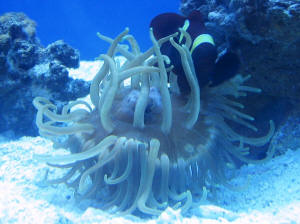
"I was in the wrong place"
but it must have been the right time".... This Premnas needs
to be separated from the Anemone. |
|
Re Anemone Looks Sick 3/19/09
Sorry to bother you....my professional recommended this website
as a place to get excellent info/answer questions about marine
aquariums....He is out of town this week, and I wanted immediate
help on my problem.
I will not bother you any further.
<Is not a problem, we were trying to help you, but got little
in the way of needed/asked for info.
Regards, James (Salty Dog)>
Robin
Re Anemone Looks Sick/Apology 3/19/09
How is that done? Take the anemone out and place him in the sump
tank?
<You can, would be much easier than trying to catch the fish.
Keep in mind this anemone is going to need intense lighting to
survive. James (Salty Dog)>
Re Anemone Looks Sick/Apology 3/19/09
Thank you for your patience with my many questions...this is my
first tank and I don't want to make any mistakes. The
lighting is 4 lights...white and blue which I have on a timer.
The anemone started to look bad when the clownfish pushed it up
against a live rock, and acted aggressive toward it. The experts
at the place where I bought everything said the clownfish is just
playing...no problem, but I disagree.
<Is normal behavior for the clown, problem is, the Condylactis
are not hosting anemones, and is the reason the anemone needs to
go, for it's own welfare. Being you are new to the hobby and
this is your first tank, be forewarned that anemones are not a
good beginner invertebrate. They are difficult to keep for any
length of time even for experienced hobbyists.
THANKS.
<You're welcome. James (Salty Dog)>
Robin
Re Anemone Looks Sick/Apology 3/20/09
Thanks for all your help and advice...much appreciated.
<You're welcome. James (Salty Dog)>
Robin
|
Anemone Decline (allelopathy) and leather coral question
(sys.) 12/5/08 I purchased live rock from an
aquarist who was moving and it included a long tentacled anemone and
clarkii clown. The anemone has done fine for about a month, moving to
his own spot and staying for most of the time. The clown often feeds
him from formula two and pieces of chopped krill that I place in the
tank. <Ah, good> Two days ago the anemone moved two feet across
the aquarium under a rock and began getting smaller, different than the
usual fluctuations. He has now moved further under the rock and totally
withdrawn and emitted a pile of mucous. <Needs to be removed...
now> He hasn't distend anything from his mouth but doesn't
open to feed or move into the light for the algae to produce food.
I've read the FAQs and other answer, but can't seem to find out
what the problem is. <A "lack of agreement" with some
other form of Cnidarian life here... in a word, Allelopathy. Read here:
http://wetwebmedia.com/cnidcompppt.htm and possibly elsewhere on WWM re
Anemones, Macrodactyla in particular if you don't understand enough
what is happening here, the need for action.> I don't want to
give up on him prematurely but don't want to risk harm to the other
inhabitants. Any thing I can do to help him out or sure way to tell
when he's dead (assuming the hermit crabs won't start eating
him as a sign). <You don't want to wait this/that long> My
second questions is regarding a small leather coral 1 1/2" long
that was on the live rock. It was partially covered by algae film. I
removed the film and placed in in my nano tank. It was knocked off the
top of the reef by a fish or crab and fell to the rear. I left it there
since I wanted to minimize stress of repeated touching and movement.
Now it has grown a 1" long stalk and attached to the rock, and all
feelers extend. My q is there anyway to relocate it (it is towards the
back and difficult to see) or is it better to leave it alone? Thanks,
Sid <If in a "very bad spot" I would move it... it cannot
move itself. Bob Fenner>
My Bright Yellow Anemone -- 10/31/08 Here is
my yellow anemone; it is much brighter than the picture shows. The
base is also yellow. <<Wowza! And even in the pic it is
glowing neon yellow! This looks to be a Heteractis/Sebae
Anemone'¦and is undoubtedly a 'dyed
specimen'>> It is in a 72 gallon tank with just under 200
watts of light. My local saltwater store who I have known for yeas
swears it's not dyed, <<Mmm'¦looking again at
the picture, one must wonder how they can 'swear' this is
not a dyed specimen>> and says my lights are strong enough.
<<Much more than just 'lighting' required keeping
these animals (and this one with strikes against it
already)>> He says the old rule of watts per gallon isn't
accurate as new style bulbs and reflectors have made lighting more
efficient. <<This 'rule' is indeed of little
use'¦but for more reasons than this. Water clarity, water
depth, feeding, 'quality' of the system, et al contributes
here>> What do you think? <<I think you have purchased
a dyed animal'¦and am concerned that your LFS would
'swear' otherwise>> How long would it take for color
to fade if it was dyed, and how long to die if my lights are really
too weak? <<You have much to worry about other than just
lighting with this (any) anemone...and a need to read
about/research the animals under your care. Please start reading
here and among the associated links:
http://www.wetwebmedia.com/coloredanemones.htm And be sure to
continue here:
http://www.wetwebmedia.com/marine/inverts/cnidaria/anthozoa/anemones.htm
>> Thanks
<<Happy to share. EricR>> |

R2: My Bright Yellow Anemone... dyed
Heteractis crispa 11/23/08 Just wanted to let you know 3
weeks later and my bright yellow anemone has faded, <<Mmm,
not surprising like we discussed>> It still yellow, buy
fairly pale at the tips. I'd say its lost 40% of its color.
Ironically I bought a pink one just as bright the same day, and
within 3 days it was pretty much all white. <<You stated
previously that your LFS owner swears he knows the source of
these animals and that they are not dyed. It would seem this
retailer is indeed trafficking in dyed animals?>> It has
been white for the last 3 weeks and has bright purple dot on the
tip of each tentacle. <<Perhaps you will be lucky and it
will recover>> My clowns play in both of them all day long;
hopefully this will give them added stimulation. <<It is,
but is only adding to the stress of these animals at this
point>> Do you think this white with purple tip is now
normal, or should it change to brownish? <<White anemones
are NOT normal? The animal is bleached as a result of being dyed,
and may or may not recover. You need to reduce the stress on
these animals, provide optimum water quality and proper feeding
for now, and wait>> The faded yellow has no dot on the tips
and I was told they are the same species. <<By your own
words you were also assured these animals were not dyed by your
LFS? Tell me, who do you believe/trust now?>> Thanks again,
Trevor <<Regards, EricR>>
R3: My Bright Yellow Anemone
� 11/23/08 Thanks again,
<<Welcome again>> I guess I'm still in shock
about the dyed anemone trade, <<All too common? And not
limited to Anemones>> I mean my local store had 20 of these
bright anemones in and they were all sold right away.
<<This is sad, truly? And I must still question your
store's assertion that these were not dyed animals (ignorance
or deception?). There are only 2 saltwater stores in our city,
and I'm sure all 20 people wont be happy that there expensive
colored anemone is not really that color. <<Indeed? A shame
all can't/won't make it/their feelings known to the store
owner>> I know I will never buy another neon pink or yellow
anemone. <<There are indeed some splendidly colored
specimens? But your photograph that you submitted with your
initial query showed an obviously dyed animal. Something that you
too may have been able to discern, with some research
beforehand>> My concern now is I can try to bring these 2
back to health, but the odds are against them surviving?
<<Yes? But some do survive the dye process>> I
don't want to lose my reef of 3 years, because when the
anemone dies it can release toxin? <<It can, yes? You will
want to keep a close eye on these Cnidarians and remove them at
the first signs of deterioration>> I'm kind of at a
point of no return? <<So it would seem. All you can do is
provide optimal care now>> I will try and maintain good
water, but at what point do I reach that dead end?
<<When/if the animals die.>> Or how do I know if
they're getting better? <<If they exhibit healthy
behavior, and begin to reclaim Zooxanthellae (will likely turn a
golden brown color if so)>> Or if it is really sick and
should be removed? <<As stated, if the animal begins to
deteriorate/dissolve/come apart, remove it/them
immediately>> They're not turning inside out, the
clowns love them, they seem very content, just the coloring is
all bleached. Any idea of timeline or something specific to watch
for? <<Just as already stated. In the mean time, do keep
reading up on the magnificent creatures. Here's another link
to start:
http://www.wetwebmedia.com/marine/inverts/cnidaria/anthozoa/heteraccrispa.htm >>
Thanks again, Trevor <<Happy to share. EricR>>
|
Anemone...Sick? 11/13/08 My sister has gone to
college, but her salt water tank is staying at my house. It is a seven
gallon tank. Her clown fish recently died, so my mother went to a pet
store and bought her a new clown fish and a long tentacle anemone.
<Uh-oh.> We have only had the anemone since yesterday, and this
morning it looked amazing. Tonight, however, it shrunk and pulled most
of the length of its tentacles inside of itself, leaving only about 1/4
of an inch of tentacles sticking out. It also expelled some kind of
white slimy-looking mucus that floated beside it for a few minutes and
then disbanded into the water. Is this normal? <Its not good.> Is
the anemone sick or simply adjusting to its surroundings? <These
require a mature system, much larger and inherently more stable than a
7 gallon (and a good bit of lighting). Unfortunately you are fighting a
losing battle here. http://www.wetwebmedia.com/macrodoreensis.htm and
the linked files above will give you more info. Scott V.><<... RETURN this
animal to the store, stat! B>>
| Please help BTA Anemone looks bad
11/2/08 Guys, <And gals...I know, way over used!> I
left this morning and things were fine. I came back at lunch and a
hermit was underneath the anemone, the BTA was as if trying to get
away unsuccessfully, and its foot below looked torn and I could see
the matter inside. (See pics) What the heck is going on? <More
info needed here. What do your water tests tell you, how old is
this system, how mature is the tank, lighting?> ThX Danny
<Reply back and we will see what we can figure out. Scott
V.> |
 |
Anemone Bleaching FAQs 8/31/08 Greetings from
NZ, oh wise ones. <Hello from Iowa! I rather like this 'wise
one' bit...maybe I'll mandate it> I picked up an anemone
(Heteractis sebae/ malu..? The one with cream-ish bubble and balloon
shaped tentacles, with supposedly luminous blue/ purple tips) a couple
of months ago, in what was admittedly a run down condition. <Tough
to find any other way...unfortunate> It was in a dim tank with T5
lighting and dozens of Aiptasia for company. Completely white, it
apparently had always been that way, and had been in the same spot for
a year or more. We encouraged it to come off the substrate and rock on
which it was perched by running a power head stream over its foot from
a distance. It settled into the spot where I put it in my reef tank,
specs below: 200-litre display with 60 litre sump and AquaC Remora
skimmer, rated for 1300 litres. System circulation/ turnover ~3500
litres per hour, and internal turnover approx 5000 litres per hour.
Nitrites/ ammonia ~0, nitrates around 20-40 ppm, <Really too high
for optimal health in this anemone> phosphate negligible through
regular filtration in sump. (No refugium). Regular dosing of reef
supplement with all soft and hard corals in prime condition, including
a fine head of Porites and Christmas trees + a couple of tridacnid
clams. Lighting 150 W metal halide + 2 actinic tubes. Back to the
anemone, it is also in fine physical condition, fed on a bit of shrimp/
mussel every couple of days, extends tentacles on cue etc, responds to
stimuli well etc. <Good.> The colour remains pretty much snowy
white/ cream. There is some brown speckling starting to appear on about
10% of the tentacles, and I am guessing this will undergo a population
explosion of sorts once the zooxanthellae hit a 'critical
mass'. <Very much so. When conditions, health reach proper
status...process speeds up.> The oral disc is a pale pink, and the
column is a rich silky cream. The anemone itself seems quite happy,
even though it is being steadfastly ignored by my Perc clown ( I will
be introducing a clarkii or similar to get results on the hosting
front). <Hosting is hit-and-miss, no matter the species. I'd
just stick with the percula, and wait. Sometimes they host after
months, or years, of ignorant behavior> My gripe is with the colour.
I anticipated the tentacles would regain their blue/ purple tips, and
sometimes a faint dark tip is visible - when the tentacles are not
fully inflated. <These may well come back with time. These pigments
are expensive to produce, and I would not expect them to return until
well after this anemone has repopulated its algal symbionts. Also keep
in mind there are variations in colouring, and not all specimens will
be as vibrant- or the same colours- as others.> Would you have any
advice on ways I can influence the coloration or do you reckon it is
likely to remain this speckled look. Would a new companion to host be
beneficial in any way? <Continue feeding good marine-origin meaty
foods. I'm not sure about the availability of products down under,
but making a frozen food from a Cyclops-eeze type product and a little
plain gelatin to be thawed in small pieces for the anemone may help
provide HUFAs and colouring compounds...also do try soaking the foods
in a vitamin supplement like Selcon. Also, a hosted fish would not aid
in this process-may hurt, as there is some stress to the anemone and
occasional damage from a hosted fish...not a perfectly balanced
symbiosis.> I searched the sheer wealth of info on your site, but
could not find anything specific to this, I apologise for the extra
long-winded query! <No trouble at all! See if you can't get the
nitrate down in your tank, and keep taking good care of that anemone,
and with time I think you'll be happy with the results.> Regards
Mani <Best wishes. Benjamin>
Re: Anemone Bleaching - 8/31/08 9/24/08 Hi Just re
the anemone you had advised me on a short while ago, I would like to
let you know it is now a speckled brown/ tan color over most of the
tentacles, and similar colored lines radiating out from the oral disc. Any thoughts on when the blue/ purple tips I am expecting should show?
It seems in overall good health, and appears to be a very fussy eater -
only fully thawed shrimp meat is accepted, and it spits out clams,
mussels, squid etc. <Good. Carry on with good care and it will color
up> I am planning to shift it to a larger, newer set up, is that
advisable, or should I just let it stay in a more mature environment?
<I would keep it in a mature environment. Let the larger set up
mature, and let this guy get totally healthy before stressing him with
a move.> Thank you for your help. Best regards Mani <No problem!
The same to you, Benjamin>
|
|

